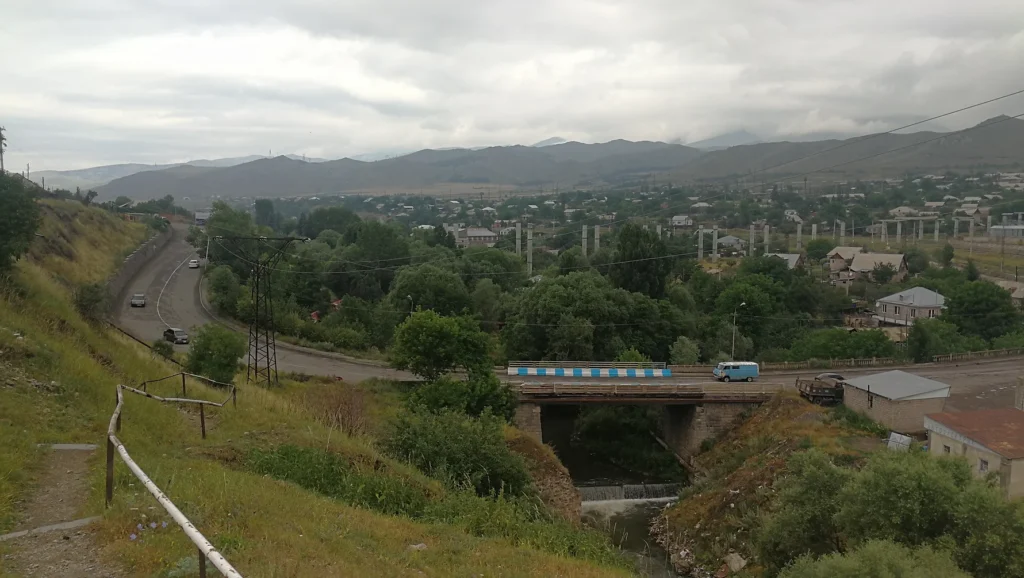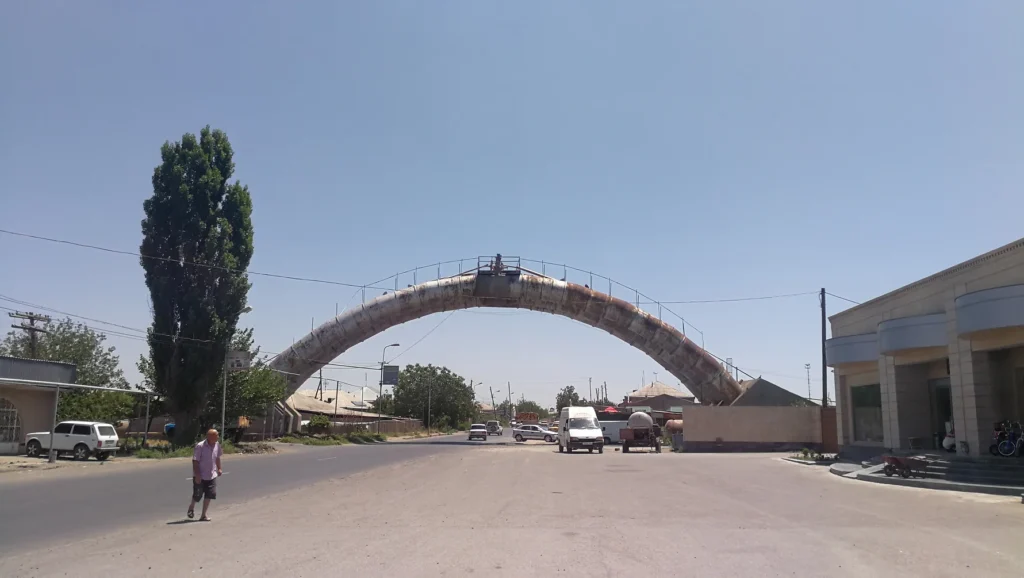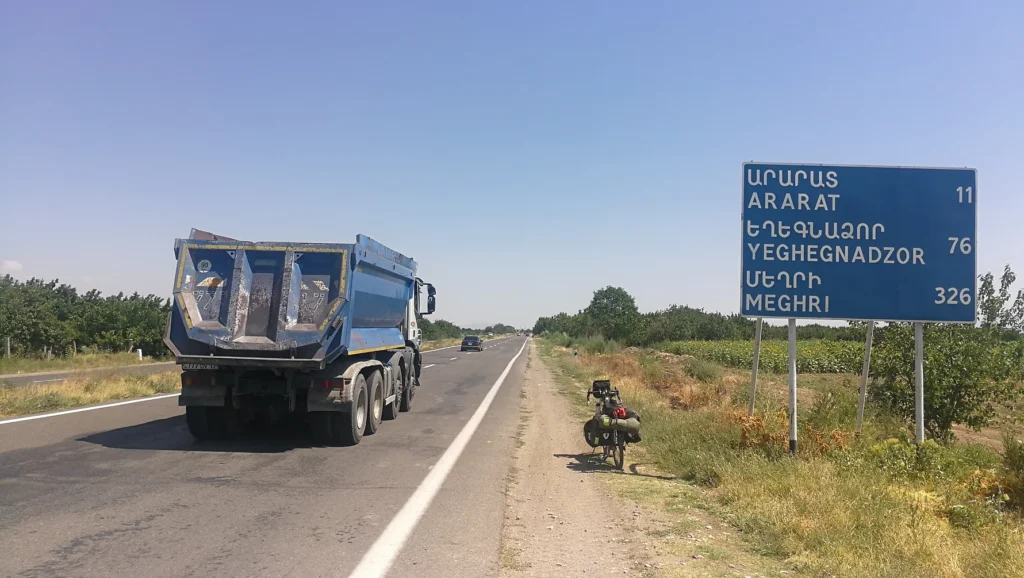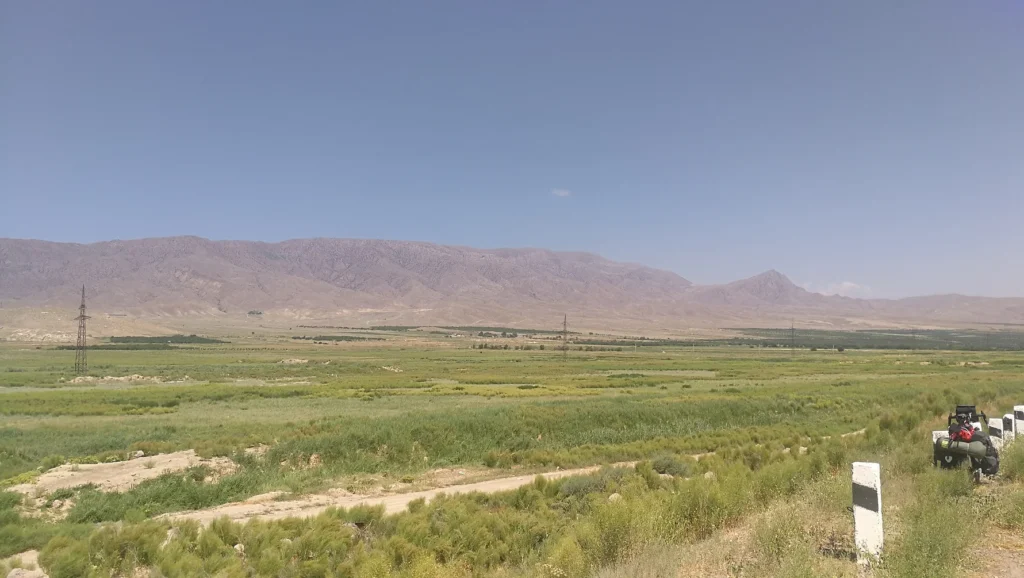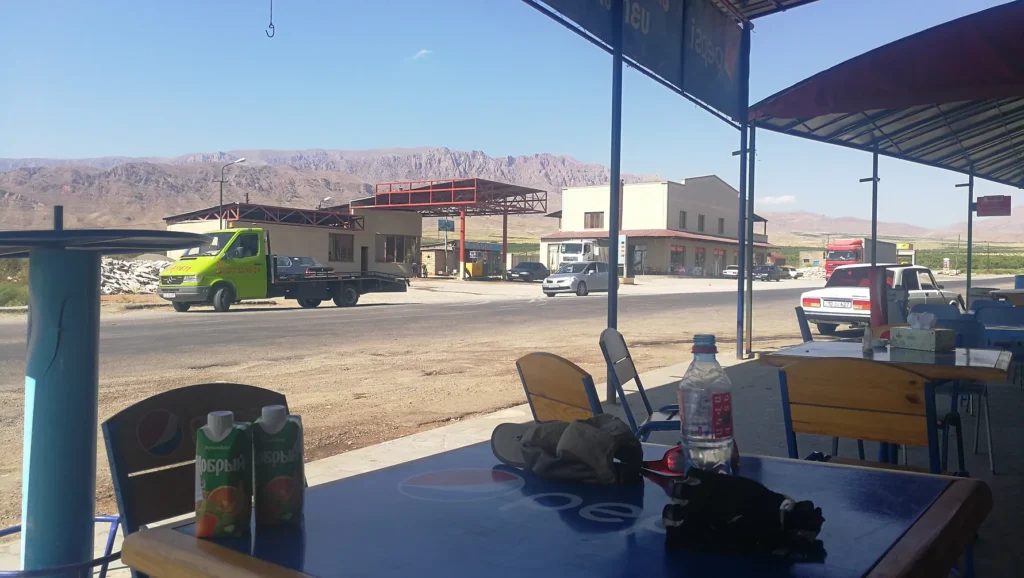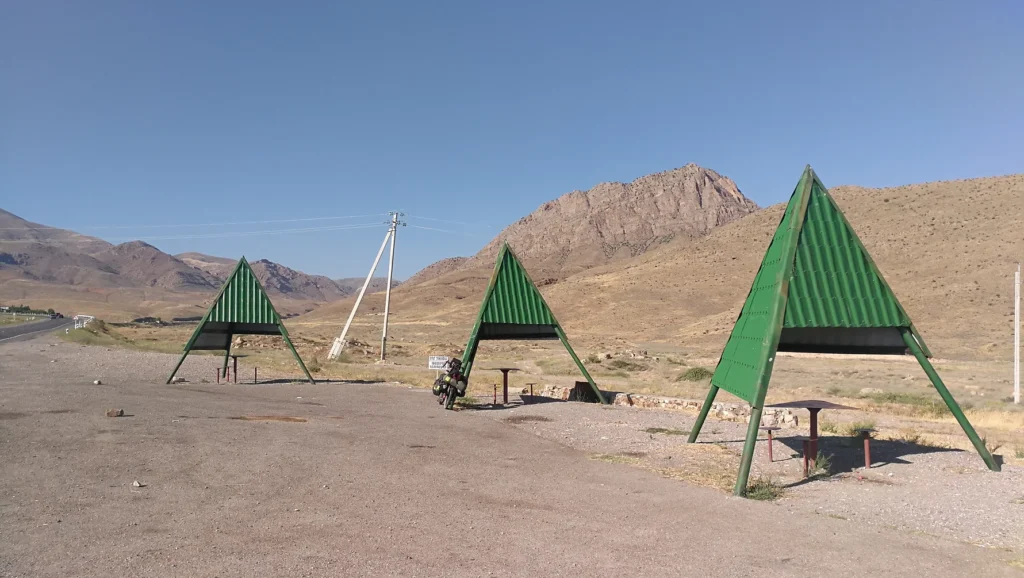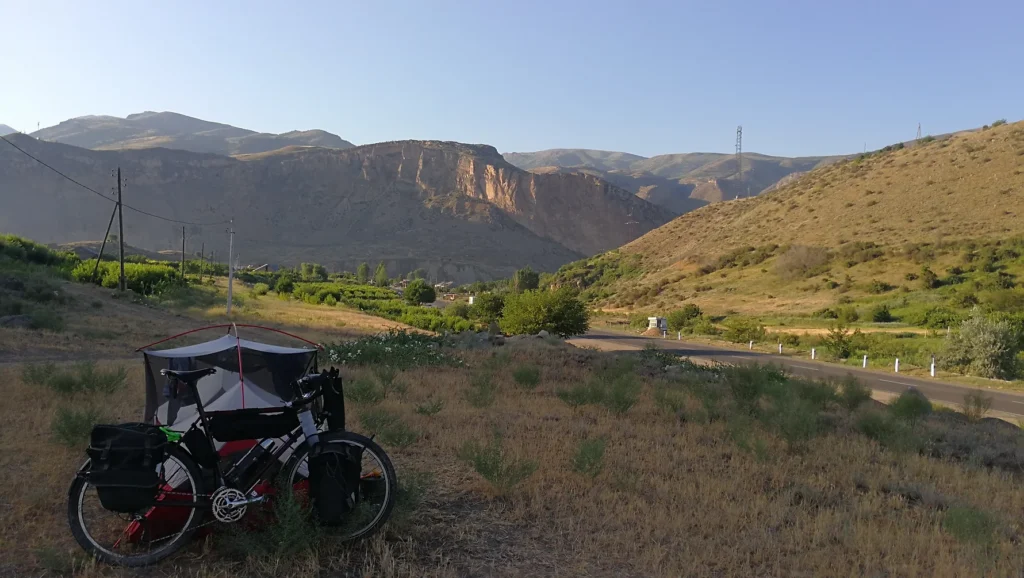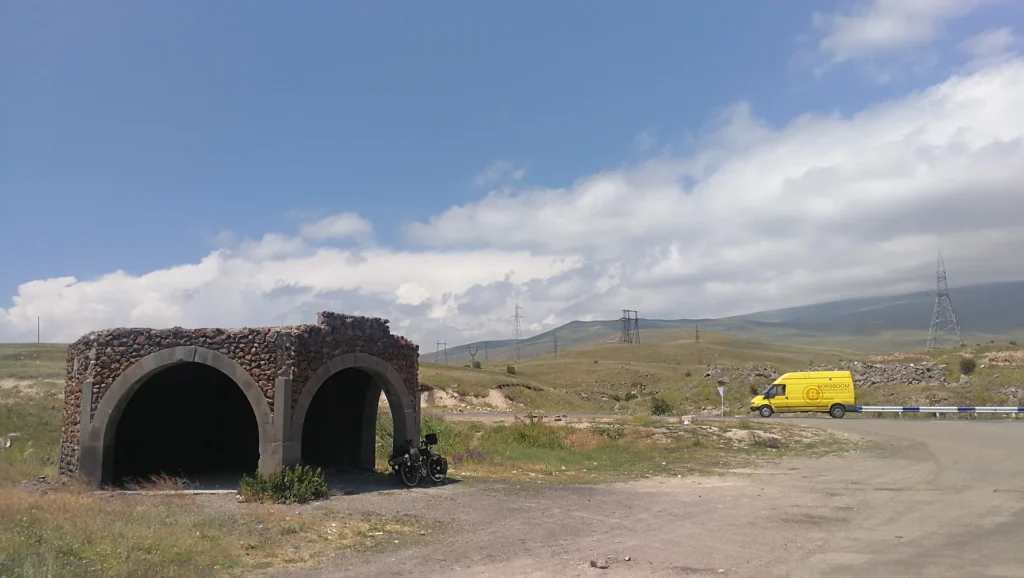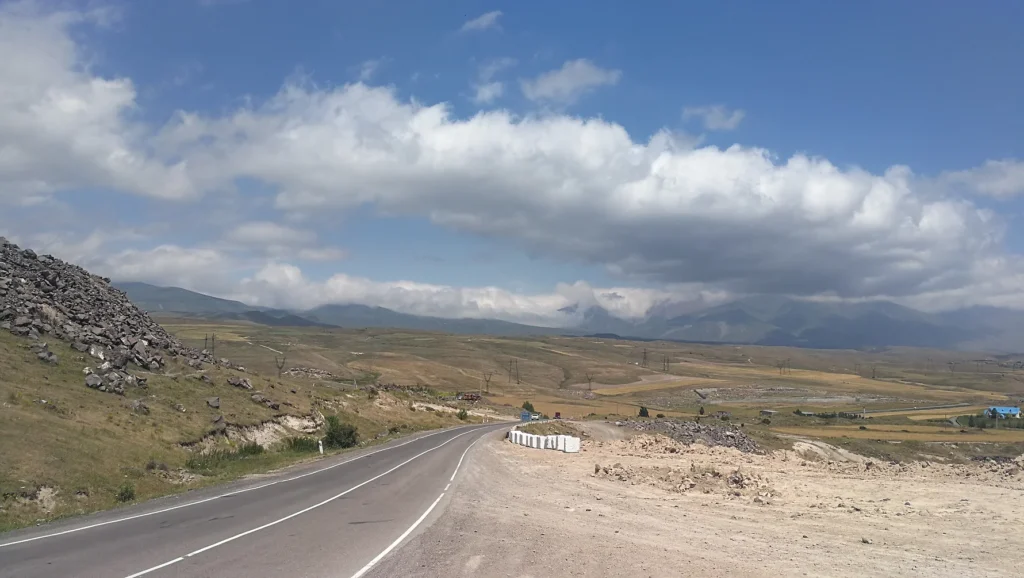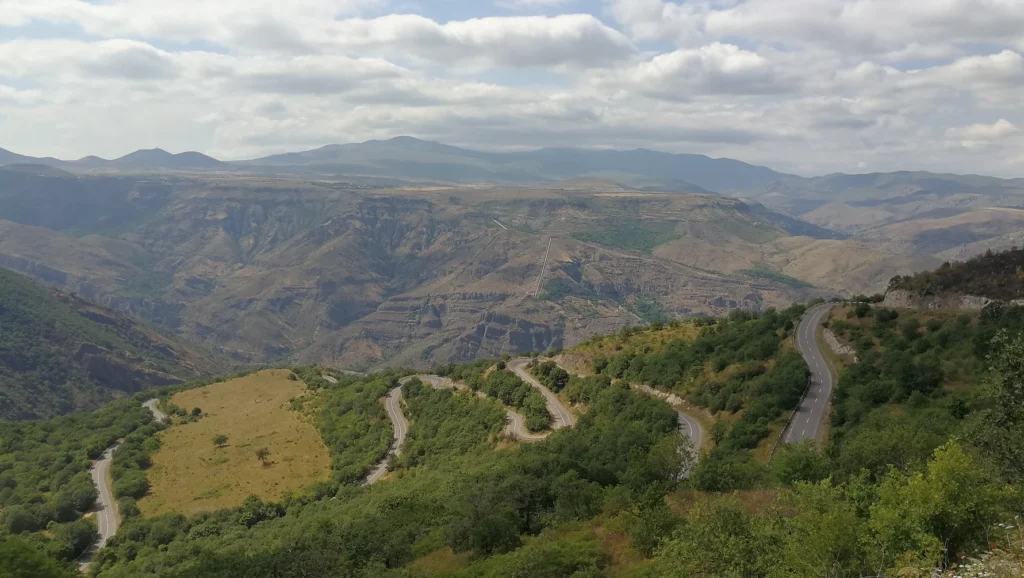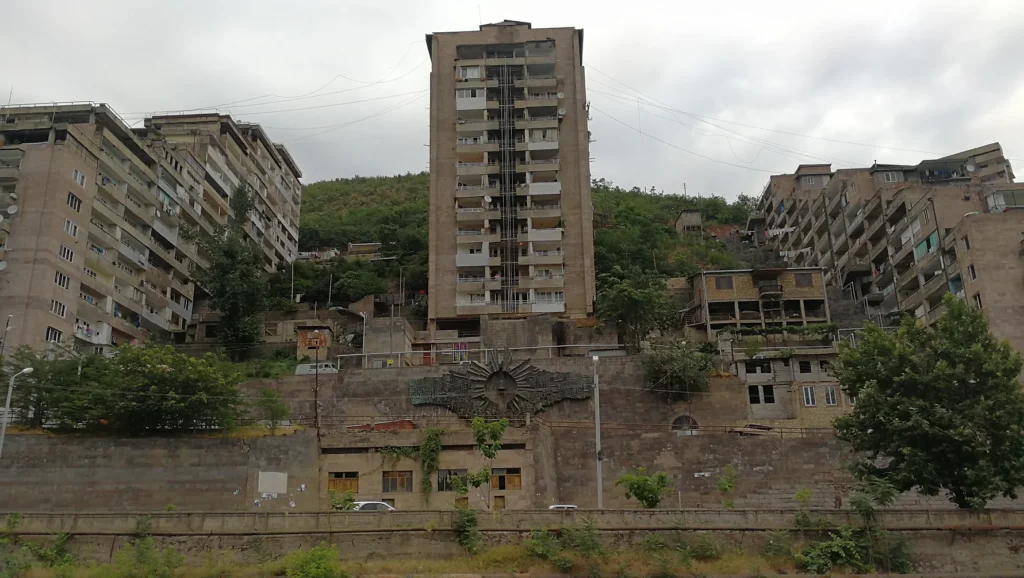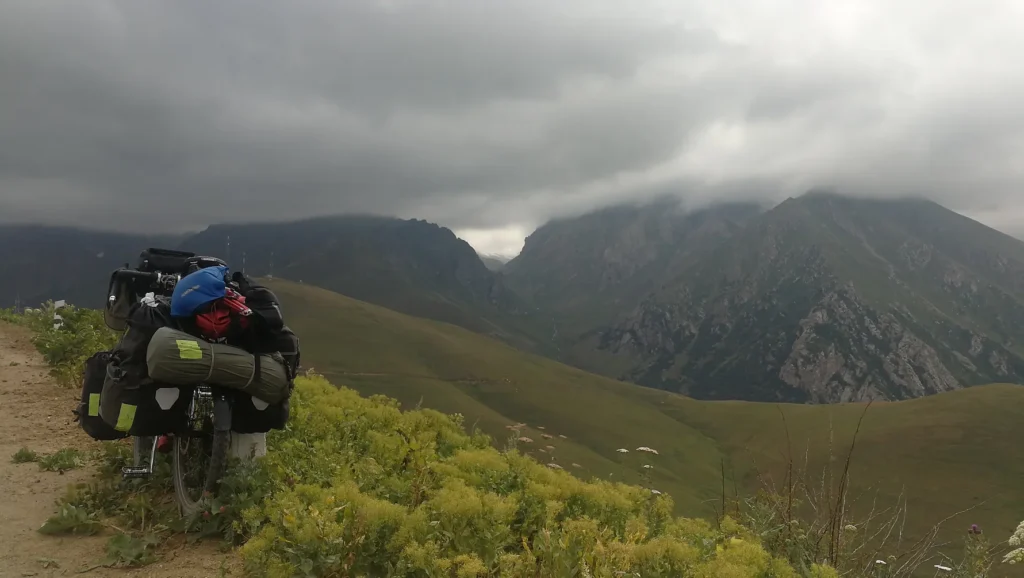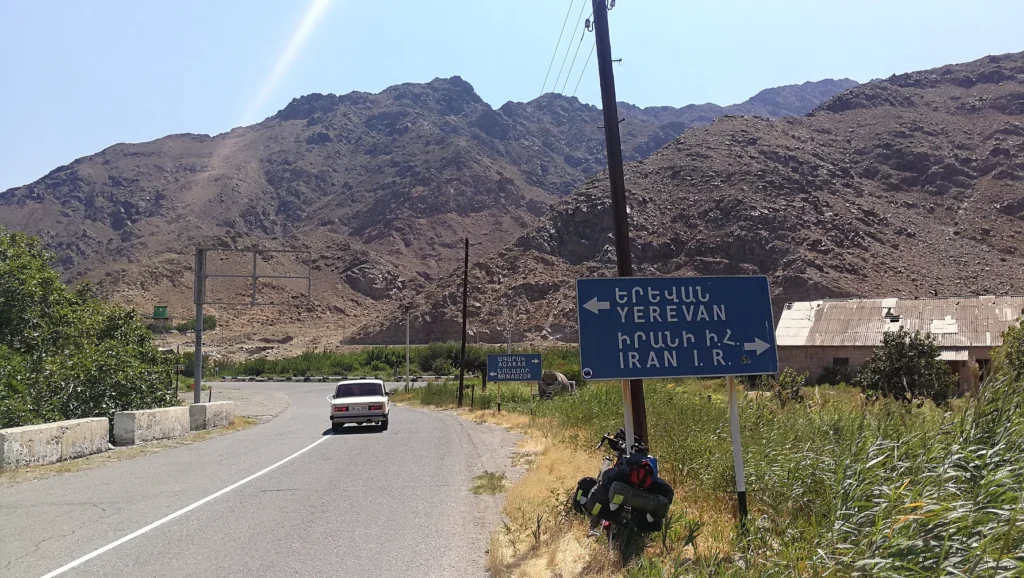Armenia — Freedom
Around noon I crossed into Armenia. Professional border check procedure, good first impression.
A stretched out uphill, a stretched out downhill – Armenia said welcome in style.
Entering Armenia at Gogavan means you first cross a large plateau at 1,500 meter surrounded by mountains up to 3,000 meter elevation. The clouds hanging between the mountains brought fresh temperatures and for the first time in weeks I rode again with a jacket.
The grassland here looked pristine and healthy as if they never use pesticides and only practice low-impact agriculture. Do you think they mow the grass on this plateau at all?
In Tashir a man invited me into his home to chat over coffee and watermelon. He was doing engravings on marble plates by hand and showed me his workshop.
The water on Armenia seems to be as healthy as the grass on the plateaus. When was the last time you saw pond lilies in the wild?
Around Saratovka the plateau looks decomposed as if the ground has sunk in.
Between Gargar and Bazum I cycled through a tunnel which was a true concentration test. About 2 kilometers long, no lighting, no side space, rough tarmac, and trucks – but Armenians are considerate drivers and things worked out well.
A car with a family stopped me to give me berries and a thumbs up that I had cycled through the tunnel – people here seem kind.
In the evening I cycled into heavy rain and decided to get a bed in the YMCA in Spitak. The staff there was fantastic and they shared many stories from daily life in Armenia.
In 1988 a devastating earthquake wiped out the city of Spitak. The earthquake killed 25,000 people in the region, disabled 140,000, and made 500,000 people homeless. It also destroyed large parts of the infrastructure and industry – more than 100 countries provided humanitarian assistance in a massive wave of solidarity and support.
The Spitak YMCA founded in 1994 is designed to both host travelers and to provide a place for the local community. I guess it was set up here to support the earthquake recovery process.
What does freedom mean to you?
Is freedom something you value?
I’m unsure if the philosophical debate around free will is relevant for our consciousness exploration. We may think we have a free will but ultimately we don’t, or the other way round – who knows.
While the question of free will is abstract, our consciousness state is concrete and observable – at every moment of our life we seem to be free to consciously choose the attention we give to our reality.
Which things do you give your attention to in your consciousness, and why? And which kind of attention do you give to things, and why?
In my view, these are two existential choices we all constantly make freely and nothing in the universe can take this decision power away from us. This is just my humble perception of how the human reality-bending force works – the ultimate truth I don’t know.
In any case, following our feelings and doing what feels right is what we experience when we choose so.
Being fundamentally free and powerful inside – how does that feel for you?
In the morning I climbed a hill to get an overview of Spitak. The city is very green, endless mountaineering opportunities are closeby, and the locals are warm-hearted – for me this would be a perfect vacation destination.
I discovered an old cemetery. Do you also sometimes wonder what happens to our human consciousness after we die?
From Spitak towards Yerevan you can either cycle past lake Sevan which is the largest freshwater lake of the Caucasus region with white sand beaches, or can cycle by the Mount Aragats volcano massif which was the route I chose.
After a gradual climb over 20 kilometer, I reached the pass at 2,100 meter elevation.
Mount Aragats is considered a sacred mountain for Armenians. Tens of thousands of Armenians danced around Mount Aragats in 2015 to celebrate their unity.
The highest peak of the volcano massif is about 4,100 meter and this mountain region contains human-made rock art from many epochs – the oldest are estimated to be more than 10,000 years old.
Today Mount Aragats preferred to remain covered in clouds which I respectfully accepted.
Today was a fantastic day to race – from the pass the next 80 km were basically a stretched out downhill all the way into Yerevan. Racing in Armenia needs high concentration due to the tarmac condition.
20 km before Yerevan I cycled through a thunderstorm like a typhoon. The rain quickly transformed the road into a river but a strong tailwind pushed me forward so I just cycled through.
Cycling through the flooded road was perhaps not smart as the rain washed a lot of dirt on the road which you don’t see in the water – I got the third flat of my tour through a piece of broken glass.
The upside was that just when I got the flat I passed a car workshop and the friendly employees let me fix my tire inside.
Close to Yerevan some gentlemen invited me for a coffee at a gas station – thanks guys!
Yerevan is cool – it’s one of the oldest continuously inhabited cities of the world with 1 million inhabitants. I decided to check into a downtown hostel and explore the city from there.
In the morning I gave my bike a good maintenance and did some visa preparation work for the countries ahead. I also bought two long cotton trousers for Iran where covering legs shows more respect.
In the afternoon I explored Yerevan – a vibrant place full of history.
Armenians had to bear a lot of pain over the last centuries. Hundreds-of-thousands of Armenians were killed in massacres and death marches by the Ottoman Empire. During World War II hundreds-of-thousands Armenians died fighting for the Soviet Union. And since Armenia’s independence in 1991 the nation fought several wars with neighboring Azerbaijan.
That’s a lot of suffering, pain and loss for a country with only 2.8 million inhabitants.
Have you ever wondered where positivity in the human consciousness comes from? No matter how much people and societies suffer, they always seem to find a positive way forward.
And people are impressively creative in finding forward-oriented activities. For example, in Yerevan I saw a sign of the “Armenia Tree Project“: planting 7 million trees, reversing desertification, initiating a backyard nursery program where villagers generate income through tree growing (1) (2) – definitely cool! Perhaps this idea can be transferred to other countries?
That’s just one example I saw in Armenia where the people impressed me with their positive attitude, progressive thinking, and creativity – where people choose to use their reality-bending force for the good.
Perhaps a positive attitude is a direct result of human freedom?
When I stopped to take a picture of Mount Ararat, two teenagers gave me half of the freshly bought bread – just like that.
Mount Ararat is a national symbol in Armenia even though it is in Turkey. It’s a dormant double volcano and with 5,100 meter elevation it’s the highest peak of Turkey and the Armenian highland.
The bible tells a story of Noah and the flood. Instructed by god who was angry about humanity’s behavior, Noah builds an ark, loads it with animals of every kind, and when the giant flood wipes out everything on earth, Noah and his family survive in the ark and settle the earth together with the animals. And the bible specifies that after the flood “on the seventeenth day of the seventh month the ark came to rest on the mountains of Ararat”.
Jordan Peterson gave a lecture series on the psychological significance of biblical stories. In a lecture on “The Psychology of the Flood” he first explains that our consciousness generally interprets the world with story-like structures to handle the complexity around us, and then argues that flood-stories can be seen as metaphors for fundamental transformations of the way we conceptualize the world:
“That’s the reemergence of chaos, that’s the flood. That’s the return to the beginning of the cosmos. That’s another way that it’s been represented mythodologically. It’s that you voyage all the way back to the beginning of the cosmos where there is nothing but undifferentiated chaos. And that’s what you are confronting.”
For our consciousness exploration, this is an additional element to consider: during our lifetime we may experience transformational changes in the way we conceptualize the world – changes so profound that afterwards our consciousness operates fundamentally different than before.
Our existential freedom to use our consciousness attention any way we like includes the freedom to be open to transformational processes.
Yes, we could run away from or even fight transformation – and such impulses are normal given that a flood wiping out fundamental parts of our old world concept may at first appear scary.
But when we muster the bravery to trust ourself and feel into the unknown at the edge of our subconsciousness, we may experience not only that there is no dragon eating us and that the whole hell thing is overrated as we will simply continue to exist, but also that we naturally feel a consciousness expansion that we like … deep healing and inner growth.
We are free to bend our reality more by controlling less.
Breathing in, breathing out.
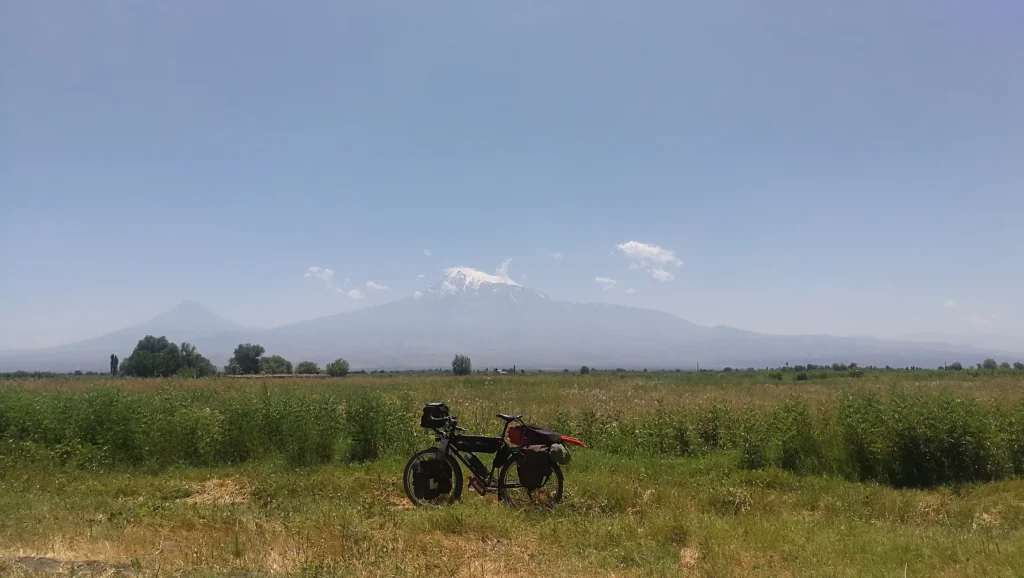
After the Yerevan break I had found my cycling rhythm again and the bike was rolling – just 330 km left until Meghri, the border town with Iran.
But I was committed to focus more on being in the present moment, not just rushing down the kilometers towards China, to really perceive the world around me with open eyes.
Riding south the landscape got dryer and changed from agriculture to a desert.
In Yeraskh I stopped for water as it’s the last village before the road takes a northwest turn into the mountains. Yeraskh directly borders the landlocked enclave Nakhchivan Autonomous Republic which belongs to Azerbaijan, and within 10 km are also borders of Turkey and Iran.
Cycling up into the mountains I was in a great spirit and really enjoyed the landscape and nature. What could possibly go wrong?
I turned out with the combination of heat and the uphill climb for hours, I drank much more water than I had estimated. From the map I had also assumed that I could get water in between as there were villages indicated, but this assumption proved wrong as I didn’t see any shops or anyone around – I ran out of water.
This was an uncritical situation as I could have always cycled back downhill to Yeraskh to get water – so I kept pushing, trying to reach the pass into the Areni valley before dark.
After three thirsty hours I decided to flag down a car and ask for water but in the evening there was no more traffic. Luckily, I found a half-full open water bottle in the roadside ditch which I happily filtered and drank. Lesson learned of the day: bring a larger water reserve in the desert and study the elevation profile a bit better.
I reached the pass at sunset, found a shop selling water, and rolled downhill under the rising full moon. I felt free, I felt good, I felt myself.
I packed up camp early and cycled east along the Arpa river.
A roadside spring in the morning, perfect. Nearby archaeologists discovered in a cave a well-preserved leather shoe dated to about 5,500 years ago, and a winery dated to about 6,000 years ago (including a wine press and storage pots) – making it the world’s oldest findings of both leather footwear and wine production.
Today people here in Areni still produce red wine and host an annual wine festival. Some things may never change, even when god sends another biblical flood.
Empty roads, great landscape – this stretch was dream cycling.
Riding in the heat makes thirsty so I cycled into Yeghegnadzor to check out some Armenian drinks – the aloe vera drink was most refreshing.
All locals are super helpful and friendly in Armenia – the young people usually speak good English.
The colors and smells in Armenia are energizing and the traffic is minimal – perfect bike meditation conditions to wake up and perceive the world openly with all senses.
In the afternoon I left the Arpa river valley behind and turned southeast towards Iran. On this stretch I met two Swiss biologists who collected field data on insects – they were confident to find new insect species no biologist has identified before.
20 km before the pass a white dog started following me – peacefully trotting behind my bike for three hours. I told him to go back several times but he didn’t listen.
I guess he needed a friend. When I started the downhill on the other side, I left him behind in about 10 seconds – I felt a bit bad as if I had disappointed his loyalty.
With one hour of daylight left and only downhill ahead, I filled my waterbags at a gas station in Gorayk and looked for a camp spot with a view.
It’s easy to feel free in Armenia – the mountain landscape embraces you gently wherever you go.
Which types of freedom do we experience in our life?
There are many different ways to be free – the choice is yours. What counts is that you truly feel free, that you truly feel good, that you truly feel yourself.
One way to be free is freedom in the sense of independence of others. This does not mean that we don’t care for others, quite the contrary. It means that we are authentic ourself and that we follow what feels right in our individual life – including an awareness of the many ways we are connected to the web of humanity, but without any particular dependency or expectation.
Freedom in the sense of independence of others means we don’t automatically follow the mainstream and we don’t blindly copy opinions and behaviors of others. It means that we think for ourself and that we choose self-reflection and forming our own opinion over external ideologies from anyone from our neighbors to temporarily elected “leaders” serving us across the spectrum of society – being free inside means we are the true leader of ourself.
Freedom in the sense of independence of others means that in your heart nobody rules you. You may choose to follow the mainstream in many ways, and you may choose to live a seemingly ordinary and calm live, and you may choose to selectively follow “leaders” when they act based on values you share – but this always remains your free choice after having observed what feels right to you, and you are always ready to withdraw anyone’s followership if it feels right.
Freedom in the sense of independence of others means you never hesitate to say a calm and confident “No” with a warm and loving smile – knowing that it’s your existential internal freedom to listen to your feelings and to also express yourself confidently. If that means you break society’s traditions, you do it and stand up for yourself and your personal values.
Let’s call this “Type A” freedom.
Another way to be free goes deeper. It’s a more universal freedom, more deeply detached. Not just from other humans, but detached more generally from the reality of the physical world surrounding us.
Let’s call this “Type B” freedom.
In my view, the process to practice these two ways to be free is nonlinear and too individual to talk much about general ways to get there. For example, the individual blockades we all carry inside our consciousness differ, and we therefore need to individually integrate our blockades to progress with any type of freedom development.
True freedom inside is a state of balance in the awareness that we constantly use our reality-bending force to bend our reality, while being detached from reality at the same time.
Perhaps we can start by becoming aware that true independence inside is possible.
Armenia is a constant up and down, and a strong headwind cost me extra energy to cycle.
Headwind costs mental energy. When you cycle up a mountain and it’s hard you are at least getting somewhere, but when cycling is hard due to headwind you are just slow.
In a roadside shelter I took a break from the wind and thought about my attitude. Perhaps by practicing “Type B” freedom I could detach myself from the wind?
Armenia is rich in secrets. Today I cycled through the area of Zorats Karer – the “Armenian Stonehenge” where 7,500 years ago over 200 stones weighting up to 10 tons were arranged. The site was only rediscovered in the 1980s …
Armenia is beautiful. The smooth lines of the landscape give the giant dimensions of the mountains something gentle and light.
Armenia is humble. It feels like a place that has so much to offer while the country doesn’t make a big deal of it.
Armenia gives you space. At most places I stopped there was nobody and I saw almost no other travelers in the entire country.
In Goris I checked into a hotel as I needed internet to organize visa things.
How is freedom related to our emotions?
Perhaps the ultimate freedom is to overcome our deepest fears to be ourself.
Feeling all our emotions, standing up tall inside our individual emotional biography, breathing free – what should hold us back given our reality-bending force?
From Goris I cycled south along the Vararak river on a border road. According to my maps the road zig-zaged between Armenia and Azerbaijan, but there was no military around and the only traffic I saw were some trucks.
Fantastic canyons along this stretch! Quite some elevation to cycle up and down repeatedly but definitely worth the views.
I followed the road past Eyvazli, an Azerbaijan village, but also here things were calm.
The views into the Nagorno-Karabakh (or Artsakh) region made me wonder: would the protagonists of this decades-long conflict act the same if they listened more to their feeling of inner freedom?
Independent of the exemplary conflict between Armenia and Azerbaijan: what is your general impression of the way countries resolve conflicts these days?
In my view, the reality-bending force inside all of us can be used more to form a world in which we don’t kill each other.
Just to be clear: I believe that existentially seen this world belongs to you, dear reader, and to your fellow human brothers and sisters living on this planet. “Leaders” and “political parties” come and go, and are always just temporary servants for the global human community – this is your world and you can shape it.
And just like you and me, also our fellow humans working in leadership positions will benefit from consciousness self-reflection in various ways – from feeling more authentic to making better decisions for others.
I generally don’t believe in the concept of “a strong leader” – I find this is a concept from the last century. In my view the problems we as humanity face are too complex and simply too many for any individual person to handle – and therefore I believe a substantial shift away from consolidated “person-power” to open debate and group decisions is required.
In my view, the world doesn’t need any longer “leaders” clinging to power, attacking free speech, censoring the press, manipulating legislative and judiciary processes, inflaming nationalism and hate, and playing with polarization and people’s fears. The world doesn’t need any longer self-focused showmen and power-maintaining political parties.
Nationalism, authoritarianism, opposition suppression, corruption – we had enough of this. In my opinion, what the world needs today across continents are true leaders who take over responsibility based on free debate and scientific research and above all personal self-reflection – leaders who understand that this century requires multinational collaboration instead of nationalism to solve our biggest global challenges.
I think self-reflection and mental clarity naturally lead to longer time horizons, and a prioritization of humanity’s key challenges over trivialities. Things like biodiversity loss, deforestation, water shortage, and climate change don’t care for “borders of a nation state”.
We need leaders good in empathy, good in farsightedness, good in network thinking, good in prioritizing universal responsibility over their ego – thus people being internally free.
Perhaps living internally free is like cycling through canyons. First you are impressed by the vast landscape ahead, but once you start you quickly realize that it’s pretty easy and a lot of fun too.
Whenever I see UN projects I feel confident about our future. I think internal freedom and international collaboration for a peaceful and sustainable world go well together.
Do you think there is a deeper meaning in the world’s conflicts?
Perhaps they are necessary to teach us the value of collaboration and peace … and the value of being free.
What is your impression of the way we treat our environment these days? Your biological body is nature too.
The area felt a bit strange, perhaps it was just the cloudy weather.
In the evening I reached Kapan, a true mining town. I liked the atmosphere so I decided to get a downtown hotel room and explore the area.
Never judge a town on first impression only – after dinner I discovered a lively area with locals sitting outside near the river, and I met the director of the Kapan State Theatre who showed me around town.
I got up early, restocked food, and cycled into the mountains towards Iran.
From Kapan to Meghri, the border crossing town into Iran, there is a western route via Kajaran and an eastern route via Tsav. The western route goes up higher, so this choice was easy.
I was happy about some cloud cover in the morning which limited the heat. In Kajaran, a small mining town, I managed to almost get lost until a local gentleman send me the right way towards Iran.
After Kajaran the first trucks with Iranian number plates appeared, probably doing cross-border trade.
I took a gamble on the water and just brought enough for the ascent and a small reserve – bringing enough water for dinner and breakfast would have been much more weight to carry uphill and today I felt like taking the risk.
What surprised me in Armenia was that you don’t really see a lot of shepherds or livestock in the mountains, be it under or over the tree line.
Jackpot – 2 kilometer before the pass a found a roadside spring and filled my water bags with 10 liter with a big smile. Sometimes when you take a risk the plan just works out fine.
I reached Meghri Pass at around 16pm and got a first glance into Iran. Foggy, windy conditions – I felt like an adventurer, I felt myself.
I pitched camp directly on the pass. Why wander far when the good is already here?
Over dinner I realized how free I felt to be here – being free definitely feels good.

I got angry about myself when I made tea after dinner. I had bought several mountain tea flowers from a man selling them at the roadside, but now I felt that I had bought too much.
Yes, it cost almost nothing and the weight was minimal. But I really dislike overconsumption and given the tea quantity in front of me I felt that I had spoiled the experience – that I distracted myself from being in the moment with simple appreciation and joy.
I decided that next time I would by only a single mountain tea flower in a small quantity – there is a point to be made for comparison, but also for focus.
How much thirst do you have in your life to dive into the unknown?
You can do it everyday while you stand in line at the supermarket, while you eat your meal, while you lay in bed under your blanket – diving into the unknown inside yourself is free and everybody can do it all the time.
A question you can ask yourself is if you want it. Do you think that following your curiosity and becoming more authentic will make you feel more alive?
Another question you can ask yourself is if you want it enough to move forward despite your fears. If you stay passive, if you avoid this question, if you distract yourself all your life – it’s also a decision and your life will pass either way shaped by yourself.
I think that you can do it – I know you can. Just look at the simple ingredients required: a dose of self-love, a dose of curiosity, a dose of courage. You already have all this inside yourself … just give it some attention in it will grow.
In a way, you need nothing to be truly free inside your consciousness. All teachings, all words, all thoughts – the more you leave them behind, the more you can feel the freedom inside yourself that you already have.
In my view, internal freedom is worth putting in some practice. Feeling more relaxed, feeling more authentic, feeling safer and braver and generally trusting more in oneself – this results in a life that’s simply overall more enjoyable, even though at times we may face our deepest hell when we look inside.
Have you already looked at the beauty of freedom today?
If not, why don’t you give it try? It’s free.
Good morning, how would you like your coffee? With a 2,000 meter elevation drop all the way down to the border crossing please. Ok, let’s go!
Breathing in, breathing out … fuck yeah!
The road in this section follows the western edge of Arevik National Park, Armenia’s youngest national park established in 2009. Beside small populations of the Armenian mouflon, Bezoar goat, and brown bears, the park is also a habitat for the Caucasian leopard.
I passed a gold mine and didn’t really care … isn’t true value only found inside our consciousness?
Sometimes life on the bike feels so easy. The bike is rolling, the lungs are breathing, and the consciousness is just fine – no need to analyze, evaluate, or improve anything.
We can always choose the ultimate freedom of accepting what is.
And when we then let go and just enjoy our life and we put on a big relaxed consciousness smile, perhaps we suddenly experience a pleasant and nurturing warm-water flood in our consciousness – a true consciousness pioneer likes to surf, right?
I reached Meghri at 11am – it looked like an inviting green oasis but I continued as I wanted to enter Iran early in the day before the heat.
Iran was just across the Aras river – a 1,000 km long river defining border lines of Turkey, Armenia, Nakhchivan Autonomous Republic, Iran, and Azerbaijan.
I reached the border crossing town Agarak around noon. Given the intense heat and the high mountains ahead I decided to cross the border early tomorrow morning.
From the border crossing most people seem to first cycle west until Jolfa and then follow the highway down to Tabriz – at least I had not found reports of cyclists riding straight south over the mountains.
Would the backcountry roads in Iran be paved? Would I find enough water? I decided to find out myself so I checked in a hotel in Agarak, did a rough route planning, and spend my last Armenian money on a two-day food supply.
What should go wrong?
Agarak downtown is pretty small – there is a central square with a monument and a supermarket. Overall pretty relaxed atmosphere.
I’m don’t know what this statue is telling the world … but I kind of like that it’s a writer and not a soldier.
In the evening I walked around Agarak’s northeast which is full of little garden plots and surprisingly green – and it offers great views into Persia.
Armenia, thank you for the impulses on freedom.













